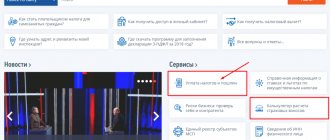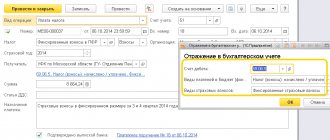Basic provisions on insurance premiums
Since the beginning of this year, insurance administration rights have been transferred to the Federal Tax Service.
The changes are enshrined in the Tax Code, namely in Chapter 34. As for the FSS NS and PZ, the specifics of accrual and payment are established by the Law of July 24, 1998 No. 125-FZ. The transfer deadlines have not changed. IMPORTANT!
The policyholder is obliged to pay the corresponding budget no later than the 15th day of the month following the billing month (in which the accruals were made).
Budgetary organizations are required to pay accrued payments to the tax authority or Social Insurance Fund at their location. Territorial branches of institutions must also pay the budget of the Russian Federation; insurance premiums for a separate division 2020 in some cases are paid by the head office, and sometimes by the branch itself. In this article we will examine in detail the question: where to pay insurance premiums for separate units.
It's time to pay your dues for 2020: a few tips
Good afternoon, dear individual entrepreneurs!
A traditional note that I write at the end of every year.
After the New Year, questions constantly appear in the comments from those who remembered about contributions only after the holidays were over =)
Therefore, just in case, I remind you once again in the form of a summary article with references to materials that I published earlier.
So, the most important thing:
By what date are dues due for 2020 due?
Fixed contributions of individual entrepreneurs “for themselves” for 2020 must be paid by December 31, 2020. But taking into account the fact that December 31 is a day off, the payment deadline is postponed to January 9, 2019.
But I strongly recommend not to delay payment until the very last day of December (and especially until January 9, 2020). It is better to pay now, without waiting for the deadline.
For example, if an individual entrepreneur using the simplified tax system pays contributions for 2020 in January 2019, then he will only be able to deduct them from the tax under the simplified tax system for 2019. Please take this into account.
How much do you need to pay for 2020?
- Contributions to the Pension Fund for oneself (for pension insurance): 26,545 rubles
- Contributions to the FFOMS for yourself (for health insurance): 5840 rubles
- Total for the full year 2020 = 32,385 rubles
- Also, do not forget about 1% of the amount exceeding 300,000 rubles of annual income
I remind you that you can subscribe to my video channel on Youtube using this link:
https://www.youtube.com/c/DmitryRobionek
I’ll immediately answer a very common question from newbies.
If you work as an individual entrepreneur for less than a full year, then contributions are recalculated taking into account the date of registration as an individual entrepreneur. That is, you will have to pay less for the full year 2020.
But I’ll tell you more about this below.
The full article + scheme about contributions for 2018 is here. Everything is told and shown in it; I see no point in repeating it.
Until what date do you need to pay 1% of the amount exceeding 300,000 rubles of annual income for 2020?
Individual entrepreneurs who have an annual income of more than 300,000 rubles know that they need to pay 1% of the amount that exceeds 300,000 rubles.
This 1% must be paid for compulsory pension insurance.
In 2020, a new law was adopted, according to which the date for payment of 1% of the amount exceeding 300 thousand rubles of annual income is postponed from April 1 to July 1. More details here.
It is clear that many individual entrepreneurs pay 1% throughout the year. But the deadline for paying 1% for 2020 is July 1, 2020.
If your income for 2020 is less than 300,000 rubles, then you do not need to pay 1% for pension insurance.
Yes, another important point for individual entrepreneurs using the simplified tax system “income minus expenses”.
I know that there are several decisions of the Supreme Court, when specific individual entrepreneurs on the simplified tax system “income minus expenses” were allowed to take into account expenses when calculating the 1% contribution to pension insurance.
But no changes were made to the Tax Code (let me remind you that we pay insurance premiums “for ourselves” to the Federal Tax Service, and not to the Pension Fund of the Russian Federation, as was previously the case). There were also many letters from the Ministry of Finance and the Federal Tax Service, in which these departments adhered to the previous position: an individual entrepreneur using the simplified tax system cannot take into account expenses when calculating the 1% additional contribution to the Pension Fund.
Read more in the letters:
- Letter of the Ministry of Finance dated 06/09/2017 No. 03-15-05/36277
- Letter of the Ministry of Finance dated March 17, 2020 N 03-15-06/15590
- Letter of the Ministry of Finance No. 03-15-03/69372 dated 10/23/2017
- Letter of the Ministry of Finance No. 03-15-07/8369
- Letter of the Ministry of Finance dated May 3, 2020 N 03-15-05/29955
- Letter of the Federal Tax Service dated July 25, 2018 No. BS-3-11/ [email protected]
All these letters are easy to find through Yandex or Google.
How to pay if there is no accounting program? Where can I get receipts or payment orders?
Just don’t download forms “from the Internet”, as is often the case =)
Use the official Federal Tax Service “Pay Taxes” service using this link:
https://service.nalog.ru/payment/index.html
If you use it, then KBK must be entered WITHOUT spaces. It’s even better to use accounting programs and services, which I constantly write about on my blog.
Now is not the time to keep records completely manually. Changes happen too often and are easy to miss.
How to calculate contributions if an individual entrepreneur has worked for less than a full year?
A very common situation is when an individual entrepreneur has been working for the first year, but opened, say, in the summer. How to calculate contributions “for yourself”?
The most reasonable option is to use accounting programs and services that calculate contributions taking into account the date of registration as an individual entrepreneur.
Or read this article, where I talked about the algorithm for calculating contributions in such cases:
A frequent question from individual entrepreneurs: how to calculate mandatory contributions “for yourself” if you have only worked for less than a year?
Just keep in mind that in this article I spoke using the example of 2017.
You can estimate your contributions in my “for yourself” contribution calculator for 2018:
Calculator of fixed contributions for individual entrepreneurs “for themselves” for 2020
And for 2020 there is already a calculator, by the way:
Calculator of fixed contributions for individual entrepreneurs “for themselves” for 2019
Which KBK should I pay for?
- For pension insurance “for yourself” 182 1 02 02140 06 1110 160
- For medical insurance “for yourself” 182 1 02 02103 08 1013 160
- At the end of 2020, for 1% of the amount exceeding 300,000, a separate BCC is not provided and it coincides with the BCC for pension insurance contributions.
PS By the way, it is possible that in 2020 there will finally be a separate KBK for the 1%. They already tried to introduce it in February 2020, but quickly abandoned this idea, since many individual entrepreneurs paid fees for the “old” BCC. Follow the news, update your accounting programs.
That's all for today.
Pay on time, don't look for trouble out of the blue =)
Important. Please note that starting from February 4, 2020, the details for paying taxes and contributions in 26 regions of the Russian Federation will change. Please read here: I recommend checking your details with your tax office after this date, as well as updating your accounting programs.
Dear entrepreneurs!
A new e-book on taxes and insurance contributions for individual entrepreneurs on the simplified tax system of 6% without employees is ready for 2020:
“What taxes and insurance premiums does an individual entrepreneur pay under the simplified tax system of 6% without employees in 2020?”
The book covers:
- Questions about how, how much and when to pay taxes and insurance premiums in 2020?
- Examples for calculating taxes and insurance premiums “for yourself”
- A calendar of payments for taxes and insurance premiums is provided
- Frequent mistakes and answers to many other questions!
Find out the details!
Dear readers, a new e-book for individual entrepreneurs is ready for 2020:
“IP on the simplified tax system 6% WITHOUT Income and Employees: What Taxes and Insurance Contributions Do I Need to Pay in 2020?”
This is an e-book for individual entrepreneurs on the simplified tax system of 6% without employees who have NO income in 2020. Written based on numerous questions from individual entrepreneurs who have zero income and do not know how, where and how much to pay taxes and insurance premiums.
Find out the details!
Payment of insurance premiums by separate divisions in 2020
For budgetary institutions that have territorial branches, the question is relevant: is there a separate division where to pay insurance premiums from the Pension Fund of Russia and the Social Insurance Fund? The answer to this depends on a number of indicators:
- Type of insurance coverage by SV administrators.
- Place of payroll.
- Registration of a separate branch or representative office with the Federal Tax Service, Social Insurance Fund and Pension Fund.
- Conditions for compulsory medical insurance, compulsory medical insurance and VniM.
If the territorial department independently calculates and pays wages to employees, then payments must be made at the location of the department. And vice versa, if payroll is calculated by the accounting department of the head office, we pay at the location of the head office.
When transferring the authority to pay employees to the department, you should not only secure these rights in the constituent documents and accounting policies, but also carry out the registration procedure with regulatory authorities. This year in the Federal Tax Service. If the right to calculate and pay wages was transferred in 2020, then it should have been registered with both the Pension Fund and the Social Insurance Fund. Branches registered last year do not have to notify the tax authorities; the Pension Fund did this for them. That is, not a single territorial department or branch that independently calculates the salaries of its employees remained unaccounted for.
Separate division, insurance premiums 2020 FSS NS and PZ
For calculations for accident insurance, a slightly different procedure is provided. The branch must meet the following requirements:
- Has its own balance. That is, in the constituent documents of a budget organization, as well as in the accounting policy, it is stated that the representative office is allocated to a separate balance sheet and keeps separate records.
- Has its own current account. The branch carries out settlements not through the accounts of the parent institution, but through its own current account opened with a banking (credit) organization.
- Performs payroll calculations. The staff accountant of the territorial office independently calculates and transfers remuneration to employees, without involving the head office.
If the branch meets all the requirements, then it is obliged to transfer insurance premiums of separate divisions in 2020 and fulfill obligations to the Social Insurance Fund independently.
Example. In 2020, the head office (Moscow) allocated a “Branch” in St. Petersburg (a separate current account and accounting department) for an independent balance sheet. In June, S.S. Sergeev was hired as a specialist. According to production needs, Sergeev performs his official duties on the territory of the “Head Office”, but his wages are calculated by the branch accountant. In such a situation, the head office does not decide: insurance premiums for a separate division, where to pay - all calculations with budgets are carried out by the branch itself at its location.
Kbk FSS: details, sample payment slip, For transfer to NS, PZ and injuries
The 4-FSS calculation for the first quarter can be submitted until May 15.
The Social Insurance Fund reported this on its website. Information about the extension of the deadline is presented in the form of a creeping line on the main page of the FSS website. “The deadline for submitting calculations for accrued and paid insurance premiums for compulsory social insurance against accidents at work and occupational diseases, as well as for the costs of paying insurance coverage for the first quarter of 2020, has been extended until May 15, 2020,” the statement said.
Budget classification codes in order to correctly transfer contributions electronically for the payment of insurance contributions for compulsory social insurance, NS and PZ to the Social Insurance Fund of the Russian Federation, and for government services. Otherwise, fines and penalties are also possible.
Have the BCCs changed for contributions to the Social Insurance Fund in 2020? No, there were no changes to the social insurance codes, it remains the same as in 2020. Below is the List of income classification codes (KBK FSS), also reserved by the Ministry of Finance of the Russian Federation to reflect payments to the FSS of the Russian Federation for organizations and individual entrepreneurs.
KBK number Purpose of transfer
| 393 1 0200 160 | Insurance premiums for employees for “injuries” |
| 393 1 0200 160 | KBC for paying penalties to the FSS from the National Tax Service in 2020 |
| 393 1 0200 160 | Fines – amounts of monetary penalties |
| 393 11700 180 | voluntary contributions from the entrepreneur |
| 393 1 1600 140 | Fines for violation of the established deadline for submitting reports to the Social Insurance Fund or failure to submit them, late registration) |
Note: If, due to an error in the KBK FSS details, the money does not go to the correct account, the policyholder will be charged a penalty.
Note: Data for payment of insurance premiums of the Moscow Social Insurance Fund
Recipient: UFK for Moscow (Governmental institution - Moscow regional branch of the Social Insurance Fund of the Russian Federation)
INN 7710030933 Checkpoint 770701001
BIC of the recipient's Bank: 044525000
Recipient's BANK: Main Department of the Bank of Russia for the Central Federal District of Moscow (Abbreviated name - Main Directorate of the Bank of Russia for the Central Federal District)
Recipient's ACCOUNT NUMBER: 40101810045250010041
For policyholders (IPs) who voluntarily entered into legal relations under compulsory social insurance in case of temporary disability and in connection with maternity:
KBK 393 11700 180 – voluntary contributions from the entrepreneur
Monetary penalties (fines) for violation of the law (for example, failure to submit a report or late submission of a report, failure to provide information about opening an account, etc.)
KBK 393 1 1600 140 – fine
Other proceeds from monetary penalties (fines) and other amounts for damages
KBK 393 1 1600 140 – administrative fine
Official website of the state institution FSS Moscow
Social insurance website: ... link Branches: ... link
If the payment order for the transfer of insurance premiums contains incorrect payment parameters:
- Federal Treasury account;
- KBK FSS contributions 2020;
- name of the beneficiary bank of the regional branch of the social insurance fund.
then the obligation to pay contributions is considered not fulfilled.
Other errors do not prevent the transfer of money to the budget or the payment of contributions, which means they will not lead to the accrual of penalties. Such shortcomings include: incorrect TIN or checkpoint of the recipient.
Note: Legal entities - firms, individual entrepreneurs paying for employees.
Note: Description of fields for filling out social security payments
How to correctly fill out a payment order to the Federal Social Insurance Fund of the Russian Federation in 2020 in case of an accident? This is a very important question, because if the money goes “by”, then the organization or individual entrepreneur will face penalties and fines.
Below is a form, a sample of filling out a payment order and a collection order in social insurance upon request to the Tax Service.
Sample payment order to the Federal CC of the Russian Federation for “injuries” Note: Here is another example of a payment order for “injuries”
So, we examined the FSS KBK for injuries, NS and PZ, penalties for insurance contributions to the FSS for the correct preparation of instructions for contributions.
- Download 4-FSS, new form, form A link is given to download the new form for 2020 for free. Excel format – Excel. Policyholder code. You can rewrite the old form 4-FSS
- EXAMPLE OF COMPLETING out the new 4-FSS form for 2020. The new 4-FSS report form for the quarter is approved by FSS Order 381. The procedure for filling out the calculation for “injuries” is given. An example of filling and a sample is provided.
Source: https://www.Assessor.ru/notebook/fss/kbk_primer_platejki_fss_travmatizm/
Features of registration of divisions
Let’s assume that the main organization has decided to transfer the authority to pay wages to the branch starting in September 2020. Consequently, changes are made to the constituent documents, as well as to the accounting policies of the organization. Within a month, you need to notify the tax authority about the transfer of powers and carry out the procedure for registering a branch with the Federal Tax Service. Registered separate division, insurance premium payers: branches themselves or territorial offices.
Another situation: the head office decided to reduce costs by optimizing staff and centralize payroll. It is also necessary to change the constituent documents and accounting policies, and then notify the tax authorities (no later than a month), then the branch will be deregistered. In this case, the answer to the question: where do separate units pay insurance premiums in 2020 is obvious. At the location of the parent organization.
Filling out a payment order
Sample payment order:
Manually
Most accountants still fill out payment slips manually, as this is more common. Explanations for filling out the document will help you avoid mistakes:
- Columns numbered 1 and 2 are filled in by banks, not payers.
- In cell number 3, enter the payment order number.
- Paragraph 4 implies the date the form was filled out.
- In cell 5 indicate the method of payment of fees: Electronically, Urgently, by mail. If you pay directly at the bank, then the column is left blank.
- In number 6 they write Payer Status in the form of a number.
- Columns 7, 8 - payment amount in numbers and words.
- Clause 9: INN/KPP, name of the enterprise or individual entrepreneur, current account, name of the bank that owns the account.
- In cell 10, enter the data of the tax authority: the bank in which the Federal Tax Service Inspectorate account is registered, the BIC of the bank, the name of the tax service and its current account.
- Column 11: Fill in - 01 (this means “Payment order”), payment queue - 5, Coding - 0.
- In cell 12: write down the KBK, OKTMO, and the basis for the payment.
- Cell 13 means the purpose of the payment - the name of the specific contribution.
- In column 14 put a signature.
Payment basis:
The payment period is also indicated here:
The document number is 0. But if this is an updated amount of payment or at the request of the tax authorities, then they put the number of the corresponding document.
A stamp is placed on the document if the payment order is completed on paper. If the payment is sent electronically, then printing is not necessary.
On the site
The electronic version of the payment order makes the task much easier by immediately offering options for filling out some details. This registration takes a little time and does not require personal presence when paying. The Pay button will do everything.
Instructions:
- When you open the main page, an example of filling out a payment form will appear. It is better to skip this point and click the Skip button and proceed to filling out the payment document.
- Select the type of contribution payer and the form of the payment document. Three options are offered. If the payer is an individual entrepreneur or an individual, then you need to select a document or payment order. If the funds are transferred by a legal entity, then there is only the last option.
- Fill in the payment type. The portal offers Type, Name and Type of payment. Select the appropriate item by clicking on the arrow at the end of the line.
- Details of the recipient of funds. The Federal Tax Service data are indicated here: IFTS code and OKTMO. They can be identified by address by checking the appropriate box.
- The payment details indicate the Payer's Status, Reason, Priority and Payment Amount. Clicking on the arrow at the end of the line will provide options.
- Payer details - data of the company that pays the insurance premium to the Federal Tax Service.
- Click the Generate payment order button, which is located in the lower right corner of the screen. The payment will be saved on your PC in PDF format.
An example of filling out a payment order form is described in detail in the video.
A responsible approach to calculating insurance premiums and issuing a payment order will save time and avoid the hassle of processing the return of excess. And using the established tariff rates, it is easy to double-check the assigned payment, which will save the company from accruing fines and penalties.
Where to pay insurance premiums for a separate unit abroad
In situations where an institution opens a branch abroad, different rules apply for contributions for separate divisions in 2020. There is no difference here whether the branch is allocated a separate balance, whether it has its own current account, whether salaries are calculated in the branch itself or not. Insurance premiums in 2020 for separate divisions located outside of Russia are always transferred to the location of the main organization. This norm is prescribed in paragraph 14 of Article 431 of the Tax Code of the Russian Federation.
Example. The “Head Office” in Moscow registered a branch “Belarus Branch” on the territory of Belarus. Where should insurance premiums be paid for a separate unit? To the Federal Tax Service and the Social Insurance Fund for the city of Moscow. Details can be found on the official websites of regulatory authorities. Don’t forget to indicate the correct BCC; this year there are new codes for OPS, compulsory medical insurance and VNiM.
Contributions to the Pension Fund and the Federal Compulsory Medical Insurance Fund for employees
In 2020, the maximum base for pension contributions = 1,292,000 rubles (Government Decree No. 1407 dated November 6, 2019).
Insurance fees do not have a fixed figure and are calculated at general rates, based on salaries, bonuses, vacation pay and other monetary compensation:
- in the Pension Fund of the for citizens of Russia - 22% of the total amount of payments for the month (limit);
- foreigners who are not qualified workers (temporarily or permanently reside in the Pension Fund) – 10% (above the limit);
- in the Federal Compulsory Medical Insurance Fund – 5.1%;
- for social insurance 2.9%, as well as contributions for injuries from 0.2 to 8.5% (the coefficient depends on the main type of activity).
The latter are transferred to the FSS branch in which the individual entrepreneur is registered as an employer, indicating KBK - 393 102 020 500 710 001 60. All other payments are sent to the tax account to which the entrepreneur belongs, indicating the following codes:
- pension contributions – 182 102 020 100 610 101 60;
- in case of disability associated with childbirth and maternity leave – 182 102 020 900 710 101 60;
- medical insurance – 182 102 021 010 810 131 60.
Carefully calculate the amounts due to the funds to avoid penalties. If during a tax audit it turns out that you erroneously underestimated the figures, you will have to pay a fine of 20% of the underpaid amount. Intentionally - then 40%.








